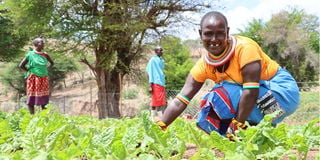The green revolution in Samburu: Pastoralists embrace vegetable farming

Para Lepeta, 33, harvests spinach in Ngilai village, Samburu East.
Lbariti Lepuyapui moves swiftly over the blossoming vegetable beds, pulling out stubborn weeds under the harsh midday sun in Ngilai village, Samburu East.
Lepuyapui's hands, roughened by years of herding cattle in the arid region, have now turned to tools of cultivation.
"This is our new venture now. We have learned that crop farming can save us greatly. We are loving this venture," he tells the Nation.
Behind Lepuyapui, a vibrant green farm thrives in a lush environment, with the leaves of the crops growing neatly despite the scorching sun.
A few goats still roam the nearby pastures, but the 42-year-old farmer is focussing on the farm, weeding the crop beds.

Pastoralists water and weed their thriving farm in Ngilai village, Samburu East.
For Lepuyapui, the land is becoming more than just a pasture for his few goats; it is now a lifeline to food security in the fight against poverty and acute malnutrition that affects children and even the elderly.
At a nearby farm, Para Lepeta, 33, harvests her bountiful crop of spinach and kale.
Lepeta is one of many Samburu women hunched over their crops, harvesting, weeding and otherwise tending to their small farms.
The once arid fields of Ngilai village have been transformed into thriving farms of kale, spinach and other green vegetables.
"We did not fancy growing vegetables here because our lives revolved around livestock keeping," says Lepeta.
"We have tested this venture and we are loving it... We are happy."
Crop farming is a new concept for the pastoralists, who have traditionally been semi-nomadic and relied on livestock as their economic mainstay.
But as climate change hits the already vulnerable region, once-predictable weather patterns are failing and severe droughts are the new norm.
This in turn is threatening the traditional way of life of the Samburu pastoralists, as more animals die from drought, increasing food insecurity and poverty.
Some pastoralists are now embracing an alternative solution: crop farming, a shift from a pastoral to an agro-pastoral system that appears to be the beginning of a green revolution.
"We are not doing away with our livestock. What we are doing is diversifying because we need alternative sources to help us cope with food insecurity challenges, poverty and malnutrition in our community," says Lepuyapui.
"At first, it felt strange tilling the land to grow vegetables instead of herding cattle. Now, I see that vegetable farming is helping my family and even bringing us some income."
Lepuyapui and his entire group of 34 pastoralists called Siligi, who collectively farm 10 acres and plan to expand their farms, received training from USAID Nawiri and they subdivided their parcels to grow vegetables.
While eating vegetables is unpopular in pastoralist communities, Lepuyapui says most members have embraced the alternative way of life after receiving training from USAID Nawiri.
"It was not easy to start this venture for the first time," says Lepuyapui.

A vegetable farm in Ngilai village, Samburu East. A group of pastoralists in the region are growing vegetables to help end acute malnutrition.
Other pastoralist groups in Samburu that have diversified into crop production include Lakira with 36 participants and Nailepunye with 38 participants.
All these pastoralist groups in Ngilai have been trained in improved farming methods, including irrigation and the use of sunken crop beds.
They have mastered the techniques of preparing the land in sunken beds to allow water retention.
According to Lepeta, two of her four children were initially malnourished due to food insecurity and poor access to a variety of foods.
"But since we started growing these vegetables, the nutrition situation is really improving. We always consider a balanced diet in our meals," says Ms Lepeta.
The USAID Nawiri partnered with the Samburu County government to help pastoralists diversify to crop farming as an alternative source of livelihood.
One of the most pressing challenges facing Samburu is malnutrition, particularly among children under the age of five.
Previous reports indicate that a large percentage of children under the age of five in Samburu are stunted due to acute malnutrition, and the traditional diet, which relies heavily on milk and meat, is insufficient to meet nutritional needs, especially during periods of drought.
The Global Acute Malnutrition (GAM) rate fell from 21.8 percent in 2022 to 17.3 percent in 2024, according to the 2024 SMART Survey conducted in June.
With the introduction of crop farming, groups are now able to grow a variety of nutritious foods, including vegetables such as spinach, tomatoes and kale.
These crops provide much-needed vitamins and nutrients to combat malnutrition.





